Stone fireplaces with integrated wood storage offer both functional and aesthetic benefits, creating a cozy and organized hearth area in your home. This comprehensive guide explores the various aspects of designing, building, and maintaining a stone fireplace with wood storage. From material selection to common pitfalls, this article provides a thorough understanding to help you achieve the perfect fireplace for your needs.
Benefits of a Stone Fireplace with Wood Storage
Enhanced Aesthetic Appeal
A stone fireplace adds a timeless elegance and rustic charm to any living space. The natural beauty of stone, with its unique textures and colors, creates a striking focal point in a room. Integrating wood storage into the design enhances this visual appeal, offering a cohesive and organized look that complements the fireplace.
The combination of stone and wood evokes a sense of warmth and tradition, making your home feel more inviting. Whether you opt for a modern minimalist design or a more traditional rustic style, a stone fireplace with wood storage can be customized to suit your aesthetic preferences.
Moreover, the presence of neatly stacked firewood adds an element of coziness and readiness, suggesting a space that is both functional and welcoming. This setup not only looks beautiful but also serves a practical purpose, ensuring you always have a supply of firewood within reach.

Functional Efficiency
One of the primary benefits of incorporating wood storage into your stone fireplace design is the increased functional efficiency it provides. Having a dedicated space for storing firewood eliminates the need to constantly fetch wood from outside, making it more convenient to keep the fire burning.
Integrated wood storage ensures that your firewood stays dry and accessible. Properly designed storage areas can protect the wood from moisture, preserving its quality and ensuring it burns efficiently. This is particularly important in regions with wet or snowy climates.
Additionally, having wood storage built into the fireplace structure maximizes space utilization. Instead of having separate storage units that take up valuable floor space, you can keep your wood neatly organized in a designated area that blends seamlessly with the fireplace.
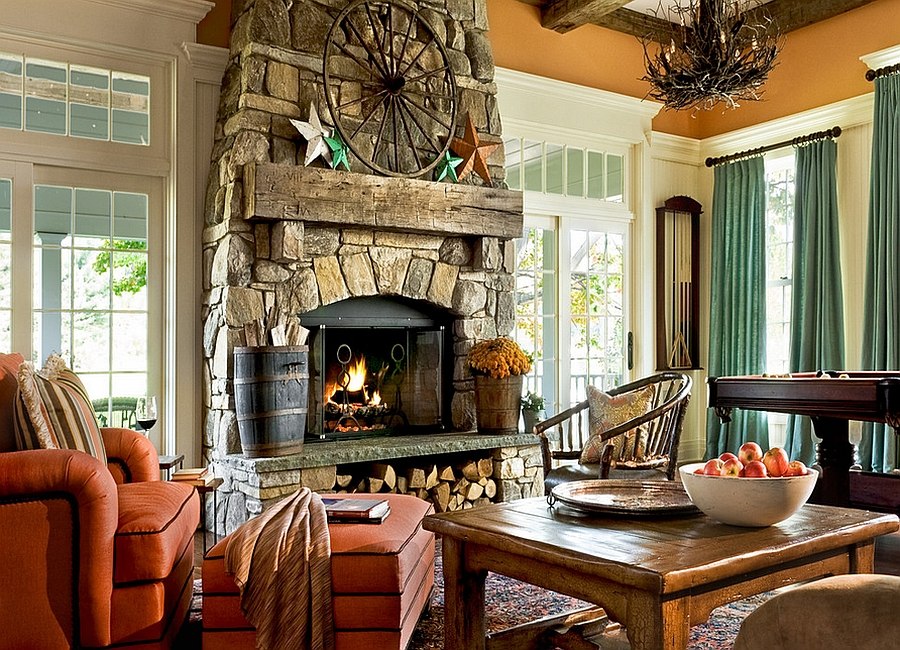
Improved Safety
Safety is a crucial consideration when designing a fireplace. Integrated wood storage contributes to a safer hearth area by keeping firewood neatly stacked and contained. This reduces the risk of tripping over loose logs or encountering pests that might be attracted to scattered wood.
A well-designed wood storage area also keeps the wood at a safe distance from the fire, reducing the risk of accidental ignition. By maintaining a clean and organized hearth, you can prevent potential fire hazards and ensure a safer environment for your family.
Moreover, having firewood stored in a designated area minimizes the mess and clutter that can accumulate around the fireplace. This makes it easier to maintain a clean and safe living space, free from debris that could pose a fire risk.

Increased Home Value
A stone fireplace with wood storage can significantly enhance the value of your home. Potential buyers often view a well-designed fireplace as a desirable feature that adds character and functionality to a property. The addition of integrated wood storage further increases the appeal by demonstrating thoughtful design and practical utility.
A fireplace serves as a central gathering point in a home, creating a warm and inviting atmosphere that many buyers find attractive. The timeless appeal of stone and the convenience of built-in wood storage can set your home apart from others on the market.
Furthermore, investing in high-quality materials and craftsmanship for your fireplace can yield a substantial return on investment. A beautifully designed and expertly constructed fireplace can be a major selling point, enhancing both the aesthetic and financial value of your home.
Versatility in Design
Stone fireplaces with wood storage offer a high degree of versatility in design, allowing you to create a look that perfectly matches your style and the architectural features of your home. Whether you prefer a sleek, modern design or a more traditional, rustic appearance, stone provides a versatile medium that can be shaped and finished to your specifications.
You can choose from a wide variety of stone types, including granite, limestone, fieldstone, and more, each offering unique textures and colors. Additionally, the layout and size of the wood storage area can be customized to suit your needs, whether you require a large capacity for frequent fires or a smaller space for occasional use.
Working with a skilled designer or architect can help you explore different design options and ensure that your fireplace meets both your aesthetic and functional requirements. This customization allows you to create a fireplace that is uniquely yours, enhancing the overall ambiance of your home.
Eco-Friendly Heating Option
Using wood as a fuel source for your fireplace is an environmentally friendly option, particularly when compared to fossil fuels. Wood is a renewable resource, and when sourced responsibly, it has a lower carbon footprint. A stone fireplace with wood storage encourages the use of sustainable heating practices by making it easier to store and access firewood.
Burning wood in a well-designed fireplace can provide efficient and effective heating, reducing your reliance on electric or gas heating systems. This can lead to lower energy bills and a reduced environmental impact.
Additionally, advancements in fireplace technology, such as the use of high-efficiency inserts and catalytic converters, have made wood-burning fireplaces more efficient and less polluting. By incorporating these technologies into your stone fireplace, you can enjoy the benefits of wood heating while minimizing environmental impact.

Interesting Articles You May Want to Check:
- Stone Fireplace Without Hearth
- Stone Fireplace Cleaning Companies
- Stone Fireplace Ideas With TV
- Update A Stone Fireplace
- Stone Fireplace Design Pictures

Designing Your Stone Fireplace with Wood Storage
Assessing Your Space
Before designing your stone fireplace with wood storage, it’s crucial to assess the available space in your home. Consider the size and layout of the room where the fireplace will be installed. Measure the dimensions to ensure that the fireplace fits well within the space without overwhelming the room.
Think about the placement of the fireplace to other elements in the room, such as windows, doors, and furniture. The fireplace should be positioned to serve as a focal point while also complementing the flow and function of the space. It’s important to strike a balance between aesthetic appeal and practical considerations.
If you have a smaller room, consider designs that maximize vertical space, such as a tall, narrow fireplace with vertical wood storage. For larger rooms, a more expansive fireplace with horizontal storage can create a grand and impressive look. Consulting with a professional designer can help you make the most of your space.
Choosing the Right Stone
The type of stone you choose for your fireplace has a significant impact on its overall appearance and functionality. Each type of stone offers unique characteristics in terms of color, texture, and durability. Granite, for example, is known for its strength and resistance to heat, making it an excellent choice for fireplaces.
Limestone and sandstone, on the other hand, offer a softer, more natural look but may require more maintenance due to their porous nature. Fieldstone provides a rustic, rugged appearance that is perfect for traditional or country-style homes. Marble, while more expensive, adds a touch of luxury and elegance.
Consider the aesthetic you want to achieve and the practical requirements of your fireplace when selecting a stone. It’s also important to think about the maintenance needs and how the stone will weather over time. High-quality stone not only enhances the visual appeal of your fireplace but also ensures longevity and durability.
Designing the Wood Storage Area
The design of the wood storage area should be both functional and aesthetically pleasing. Consider how much wood you need to store and how frequently you use your fireplace. The storage area should be large enough to hold an adequate supply of firewood while also being easily accessible.
Incorporating wood storage into the design of the fireplace can be done in several ways. Built-in niches on either side of the fireplace offer a balanced and symmetrical look. A single large storage area beneath the fireplace can provide ample space while keeping the wood neatly contained.
Think about the overall style and design of your fireplace when planning the wood storage. For a rustic look, consider using natural stone or reclaimed wood for the storage area. For a more modern design, sleek metal racks or minimalist stone shelves can create a clean and contemporary appearance.
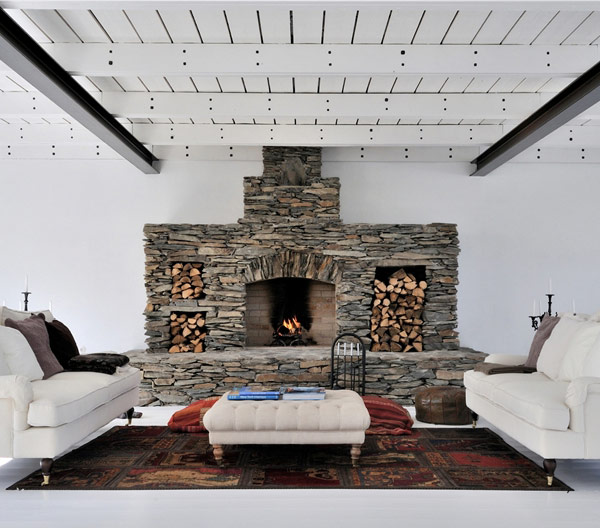
Ensuring Proper Ventilation
Proper ventilation is essential for the safe and efficient operation of your fireplace. A well-designed chimney or flue system ensures that smoke and gases are safely vented out of your home, preventing potential health hazards and maintaining indoor air quality.
When designing your stone fireplace, work with a professional to ensure that the ventilation system meets all safety standards and building codes. The height and diameter of the chimney, as well as the placement of the flue, are critical factors that influence the efficiency of your fireplace.
Proper ventilation also helps improve the combustion process, ensuring that your fire burns efficiently and produces more heat. This can reduce the amount of wood you need to burn and minimize emissions, making your fireplace more environmentally friendly.
Integrating Additional Features
Consider integrating additional features into your fireplace design to enhance its functionality and aesthetic appeal. Features such as a mantel, hearth, and built-in seating can add both visual interest and practical benefits to your fireplace area.
A mantel provides a convenient place to display decorative items, such as artwork, photographs, or seasonal decorations. The hearth extends the fireplace area, offering a safe and stable surface for tending the fire and placing fire tools. Built-in seating, such as stone benches, creates a cozy and comfortable space for enjoying the warmth of the fire.
Lighting is another important consideration. Installing ambient or task lighting around the fireplace can enhance the ambiance and make the area more functional. Recessed lighting, wall sconces, or even a chandelier can add a touch of elegance and ensure that the fireplace remains a focal point even when the fire is not lit.
Budgeting and Planning
Proper budgeting and planning are essential for the successful execution of your fireplace project. Begin by determining your overall budget, considering all aspects of the project, including materials, labor, permits, and additional features. A clear budget helps you make informed decisions and avoid unexpected expenses.
Research the cost of different types of stone and other materials to understand the range of prices. Get detailed quotes from multiple contractors to compare prices and services. Factor in additional costs for features such as mantels, hearths, and custom wood storage solutions.
Create a detailed project plan that outlines the steps involved, the timeline, and the responsibilities of each party. This helps ensure that the project stays on track and within budget. Working with a professional designer or contractor can provide valuable guidance and help you navigate the complexities of the project.
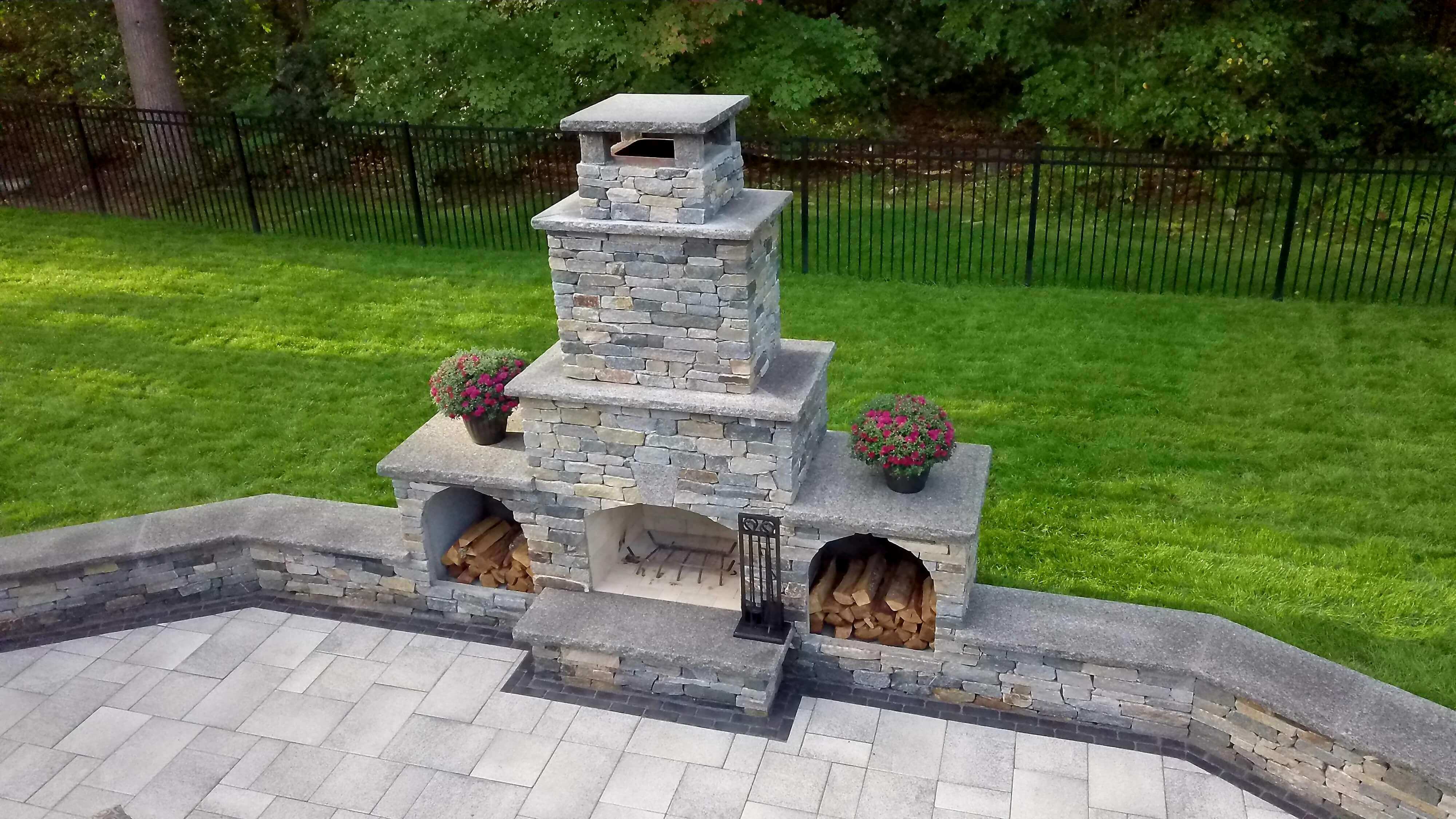
Building Your Stone Fireplace with Wood Storage
Hiring the Right Professionals
Building a stone fireplace with wood storage requires a high level of skill and expertise. Hiring the right professionals is crucial to ensure that the project is completed safely, efficiently, and to a high standard. Start by seeking recommendations from friends, family, or online reviews to find reputable contractors.
Look for professionals who have experience with stone masonry and fireplace construction. Check their credentials, ask for references, and view examples of their previous work. It’s important to choose contractors who are licensed, insured, and familiar with local building codes and regulations.
Once you’ve selected a contractor, work closely with them to communicate your vision and expectations. A good contractor will provide valuable insights, help you navigate design choices, and ensure that the project is completed to your satisfaction.
Preparing the Site
Proper site preparation is essential for the successful construction of your fireplace. Start by clearing the area where the fireplace will be installed. This may involve removing existing structures, leveling the ground, and ensuring that the site is accessible for construction equipment and materials.
The foundation of the fireplace is a critical component that supports the structure and ensures its stability. Depending on the design and size of your fireplace, this may involve pouring a concrete slab or constructing a reinforced base. The foundation must be level, stable, and capable of supporting the weight of the stone and wood storage.
It’s also important to consider factors such as drainage and ventilation during site preparation. Ensure that water runoff is directed away from the fireplace to prevent moisture damage. Proper ventilation helps prevent smoke and gases from accumulating in your home, ensuring safe and efficient operation.
Constructing the Fireplace
The construction of the fireplace involves several key steps, each requiring careful attention to detail and skilled craftsmanship. Start by building the firebox, which is the chamber where the fire will burn. The firebox should be constructed from heat-resistant materials such as firebrick and mortar to withstand high temperatures.
Next, construct the outer shell of the fireplace using the chosen stone. The stone should be laid in a pattern that complements the design and provides structural integrity. Mortar is used to bond the stones together, and it’s important to ensure that the joints are properly sealed to prevent air leaks.
The chimney or flue system is another critical component that must be constructed to precise specifications. This involves building a vertical shaft that allows smoke and gases to vent safely out of your home. The chimney must be properly aligned and capped to prevent rain and debris from entering.

Installing Wood Storage
The installation of wood storage involves creating a designated area within the fireplace structure to store firewood. This can be done by constructing niches or alcoves using stone, brick, or other materials. The storage area should be designed to hold an adequate supply of firewood while keeping it organized and accessible.
Consider the size and layout of the wood storage area to ensure that it meets your needs. The storage area should be easily accessible for adding and retrieving firewood. Proper ventilation is important to prevent moisture buildup and ensure that the wood stays dry and ready to burn.
Integrating the wood storage into the overall design of the fireplace creates a cohesive and visually appealing look. Whether you opt for a simple, functional storage area or a more elaborate design with decorative elements, the wood storage should complement the style of the fireplace.
Adding Finishing Touches
The finishing touches are what transform your fireplace from a functional structure into a beautiful focal point in your home. This includes adding features such as a mantel, hearth, and decorative elements. The mantel provides a surface for displaying items, while the hearth extends the fireplace area and adds visual interest.
Consider the materials and design of the finishing touches to ensure that they complement the overall look of the fireplace. For example, a wooden mantel can add warmth and contrast to a stone fireplace, while a stone hearth can enhance the rustic charm.
Lighting is another important consideration. Installing ambient or task lighting around the fireplace can enhance the ambiance and make the area more functional. Recessed lighting, wall sconces, or even a chandelier can add a touch of elegance and ensure that the fireplace remains a focal point even when the fire is not lit.
Final Inspection and Testing
Once the construction is complete, it’s important to conduct a final inspection and testing to ensure that the fireplace is safe and functional. This involves checking the structural integrity, ventilation system, and overall workmanship. A professional inspection can help identify any issues that need to be addressed.
Testing the fireplace involves lighting a small fire to check the draw of the chimney and the performance of the ventilation system. Ensure that smoke and gases are venting properly and that the fire burns efficiently. This is also an opportunity to test any additional features, such as gas burners or lighting.
Address any issues or concerns that arise during the inspection and testing phase to ensure that your fireplace is safe and ready for use. Proper maintenance and regular inspections will help ensure that your fireplace continues to provide warmth and beauty for years to come.
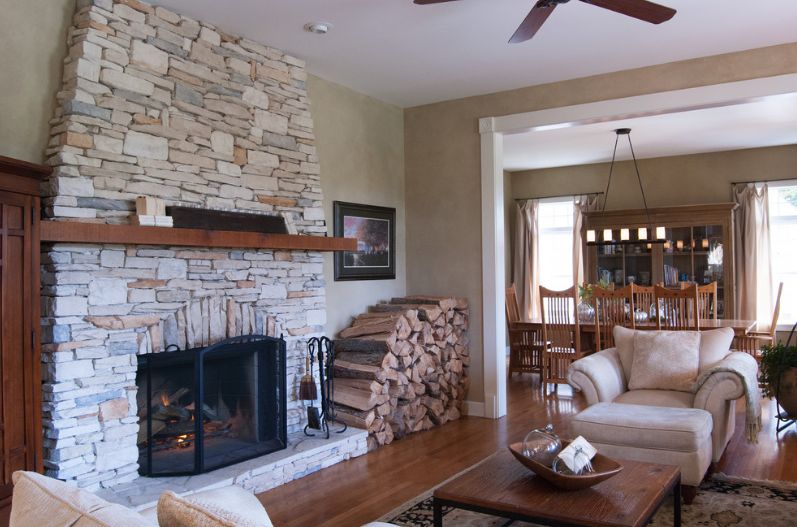
Maintaining Your Stone Fireplace with Wood Storage
Regular Cleaning and Inspection
Maintaining your stone fireplace with wood storage requires regular cleaning and inspection to keep it in good condition and ensure safe operation. Start by removing ashes and debris from the firebox after each use. This helps prevent buildup that can obstruct airflow and create a fire hazard.
Clean the stone surfaces periodically to remove soot, smoke stains, and dust. Use a stone-safe cleaner and a soft brush to avoid damaging the stone. For tougher stains, a mixture of water and mild detergent can be effective. Avoid using harsh chemicals or abrasive tools that can scratch or discolor the stone.
Inspect the fireplace and wood storage area regularly for signs of damage or wear. Look for cracks, loose stones, or deteriorating mortar that may need repair. Check the chimney or flue system to ensure that it is clear of obstructions and functioning properly. Regular maintenance helps prevent more serious issues and extends the life of your fireplace.
Sealing and Protecting the Stone
Sealing the stone surfaces of your fireplace can help protect them from moisture, stains, and weathering. A high-quality stone sealer creates a barrier that repels water and prevents dirt and soot from penetrating the stone. This makes cleaning easier and helps maintain the appearance of your fireplace.
Apply a stone sealer according to the manufacturer’s instructions, typically every one to three years depending on the type of stone and the level of use. Before applying the sealer, clean the stone thoroughly and allow it to dry completely. Use a brush or roller to apply an even coat of sealer, and allow it to cure for the recommended time.
In addition to sealing, consider other protective measures such as using a fireplace screen or glass doors to contain sparks and prevent damage to the stone. These protective features can also enhance safety and improve the efficiency of your fireplace.
Managing Firewood
Properly managing your firewood supply is essential for maintaining a clean and efficient fireplace. Store firewood in the designated storage area, keeping it neatly stacked and organized. Ensure that the storage area is well-ventilated to prevent moisture buildup and keep the wood dry.
Use seasoned hardwood for the best performance. Seasoned wood has been dried for at least six months to a year, reducing its moisture content and allowing it to burn more efficiently. Avoid burning green or unseasoned wood, as it produces more smoke and can lead to creosote buildup in the chimney.
Rotate your firewood supply to ensure that older wood is used first. This helps prevent rot and ensures that you always have a supply of dry, seasoned wood ready to burn. Regularly inspect your wood storage area for signs of pests or moisture and address any issues promptly.

Addressing Repairs Promptly
Addressing repairs promptly is crucial to maintaining the integrity and safety of your stone fireplace. Small issues, such as cracks or loose stones, can quickly escalate into more serious problems if not addressed. Regular inspections help identify these issues early, allowing for timely repairs.
For minor repairs, such as filling small cracks or replacing a few loose stones, you may be able to handle the work yourself with the right materials and tools. However, more extensive repairs, such as rebuilding sections of the fireplace or chimney, should be handled by a professional mason.
Ignoring needed repairs can lead to safety hazards, such as compromised structural integrity or the risk of fire. By addressing repairs promptly, you can ensure that your fireplace remains a safe and beautiful feature in your home.
Enhancing Efficiency
Enhancing the efficiency of your fireplace can improve its performance and reduce the amount of wood you need to burn. One way to increase efficiency is to install a fireplace insert or high-efficiency stove. These devices are designed to maximize heat output and minimize emissions, making your fireplace more environmentally friendly.
Ensure that the chimney and flue system are properly maintained to improve airflow and combustion. Regularly clean the chimney to remove creosote buildup, which can obstruct airflow and reduce efficiency. A clean and properly functioning chimney helps ensure that your fire burns hotter and cleaner.
Consider using firewood that is specifically selected for its efficiency and heat output. Hardwoods, such as oak, maple, and hickory, burn hotter and longer than softwoods, providing more heat with less wood. Properly managing your firewood supply and using high-efficiency devices can significantly enhance the performance of your fireplace.
Seasonal Maintenance
Seasonal maintenance is essential to keep your stone fireplace with wood storage in top condition throughout the year. Before the heating season begins, conduct a thorough inspection and cleaning. Remove any debris from the chimney and flue, and ensure that the ventilation system is functioning properly.
Check the stone surfaces for any signs of damage or wear, and apply a fresh coat of sealer if needed. Ensure that your firewood supply is properly seasoned and stored, and stock up on wood for the winter months. Perform any necessary repairs or maintenance to ensure that your fireplace is ready for use.
At the end of the heating season, clean the firebox and chimney, and inspect the stone surfaces for any signs of wear or damage. Proper seasonal maintenance helps ensure that your fireplace remains a safe, efficient, and beautiful feature in your home.
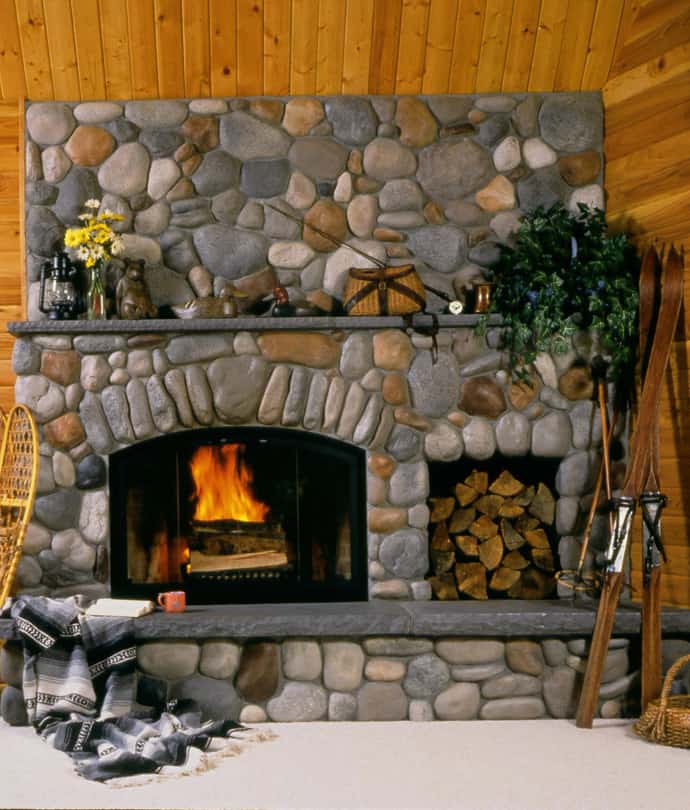
Common Mistakes to Avoid
Using Improper Materials
One of the most common mistakes when building a stone fireplace with wood storage is using improper materials. Selecting the wrong type of stone, mortar, or firebrick can compromise the structural integrity and safety of the fireplace. It’s important to use materials that are specifically designed for high-heat environments and that can withstand the stresses of regular use.
Consulting with a professional and conducting thorough research can help you choose the right materials for your fireplace. Ensure that the stone is of high quality and suitable for fireplace construction, and use heat-resistant mortar and firebrick for the firebox.
Neglecting Proper Ventilation
Proper ventilation is crucial for the safe and efficient operation of a fireplace. Neglecting to install a properly designed chimney or flue system can lead to smoke and gases accumulating in your home, posing serious health risks. It’s important to work with a professional to ensure that the ventilation system meets all safety standards and building codes.
Regularly cleaning and maintaining the chimney and flue system is also essential to prevent obstructions and ensure efficient airflow. Ignoring ventilation issues can lead to reduced efficiency, increased emissions, and potential safety hazards.
Poor Firewood Management
Improper management of firewood can lead to several issues, including inefficient burning, increased smoke, and creosote buildup. Using green or unseasoned wood, storing wood in damp or poorly ventilated areas, and failing to rotate your firewood supply can all contribute to these problems.
Ensure that your firewood is properly seasoned and stored in a dry, well-ventilated area. Use a rotation system to ensure that older wood is used first, and regularly inspect your wood storage area for signs of pests or moisture.

Skipping Regular Maintenance
Skipping regular maintenance can lead to a range of issues, from decreased efficiency to serious safety hazards. Regularly cleaning the firebox, chimney, and stone surfaces, as well as addressing repairs promptly is essential to keep your fireplace in good condition.
Ignoring maintenance tasks can result in the accumulation of soot, creosote, and debris, which can obstruct airflow and increase the risk of fire. Regular inspections and maintenance help identify issues early and ensure that your fireplace remains safe and functional.
Overloading the Firewood Storage
Overloading the firewood storage area can compromise the structural integrity of your fireplace and create safety hazards. Storing too much wood in a small space can lead to instability, making it difficult to access the wood safely and increasing the risk of accidents.
Design the wood storage area to accommodate a reasonable amount of firewood based on your needs and the available space. Avoid overloading the storage area and ensure that the wood is neatly stacked and organized.
Ignoring Professional Advice
Ignoring professional advice and attempting to design or build a stone fireplace without the necessary expertise can lead to costly mistakes and potential safety hazards. It’s important to consult with experienced professionals, including designers, architects, and masons, to ensure that your fireplace is properly designed and constructed.
Professional advice can help you make informed decisions about materials, design, and construction, ensuring that your fireplace meets all safety standards and performs efficiently. Investing in professional guidance can save you time, money, and potential issues in the long run.

How much does it cost to build a stone fireplace with wood storage?
The cost of building a stone fireplace with wood storage can vary widely based on several factors, including the type of stone, the complexity of the design, and the cost of labor. On average, you can expect to pay between $5,000 and $20,000 for a custom stone fireplace with integrated wood storage. High-end materials, custom designs, and additional features such as mantels and hearths can increase the cost. It’s important to get detailed quotes from multiple contractors and factor in all aspects of the project when budgeting.
What type of stone is best for a fireplace?
The best type of stone for a fireplace depends on your aesthetic preferences and practical requirements. Granite is a popular choice due to its strength and heat resistance, making it an excellent option for fireplaces. Limestone and sandstone offer a softer, more natural look but may require more maintenance. Fieldstone provides a rustic, rugged appearance that is perfect for traditional or country-style homes. Marble adds a touch of luxury and elegance but comes at a higher cost. Consider the look you want to achieve and the maintenance needs when selecting the stone.
How do I maintain a stone fireplace with wood storage?
Maintaining a stone fireplace with wood storage involves regular cleaning and inspection. Remove ashes and debris from the firebox after each use and clean the stone surfaces periodically to remove soot, smoke stains, and dust. Use a stone-safe cleaner and avoid harsh chemicals or abrasive tools. Seal the stone surfaces every one to three years to protect them from moisture and stains. Properly manage your firewood supply by storing it in a dry, well-ventilated area and using seasoned wood. Regularly inspect the fireplace and wood storage area for signs of damage or wear and address repairs promptly.
Can I build a stone fireplace with wood storage myself?
Building a stone fireplace with wood storage is a complex project that requires a high level of skill and expertise. While some experienced DIY enthusiasts may be able to handle certain aspects of the project, it’s generally recommended to work with professional masons and contractors. Professionals can ensure that the fireplace is constructed safely, meets all building codes, and performs efficiently. They can also provide valuable guidance on design choices and materials. Attempting to build a fireplace without the necessary expertise can lead to costly mistakes and potential safety hazards.
What are the benefits of integrating wood storage into a fireplace design?
Integrating wood storage into a fireplace design offers several benefits. It enhances the aesthetic appeal of the fireplace by creating a cohesive and organized look. Integrated wood storage increases functional efficiency by keeping firewood neatly stacked and easily accessible, eliminating the need to fetch wood from outside. It improves safety by containing firewood and reducing the risk of tripping over loose logs. Built-in storage also maximizes space utilization and can increase the value of your home by demonstrating thoughtful design and practical utility.

Related Posts:
- Stone Fireplace Makeover Ideas
- Stone Fireplace With Built In Bookcases
- Stone Fireplace Ideas With TV
- Stacked Stone Fireplace With White Mantle
- How To Paint A Stone Fireplace White
- Stone Fireplace Facing Kits
- Stone Fireplace Accent Wall
- Stone Fireplace Repair
- French Country Stone Fireplace
- Old World Stone Fireplace